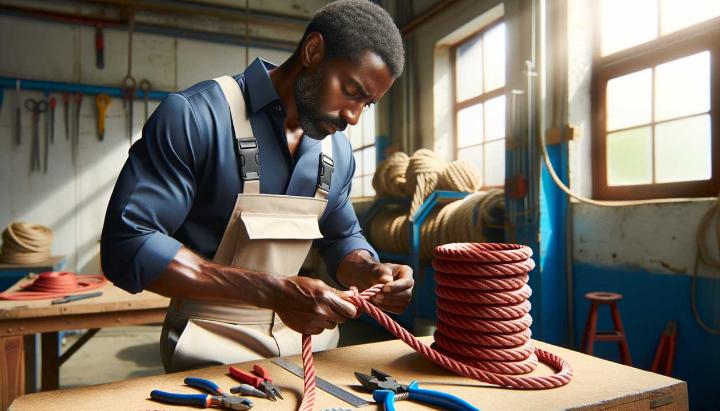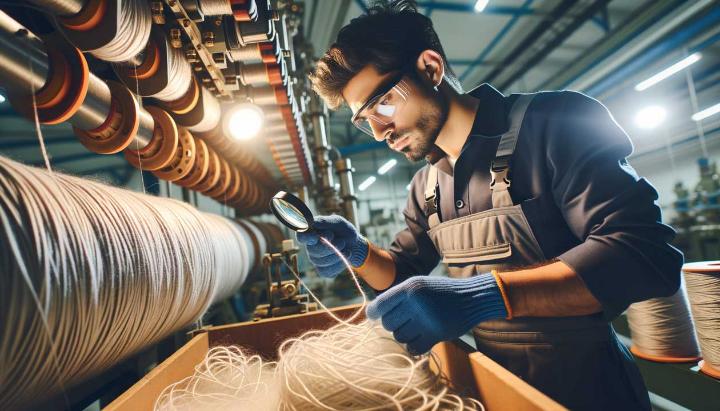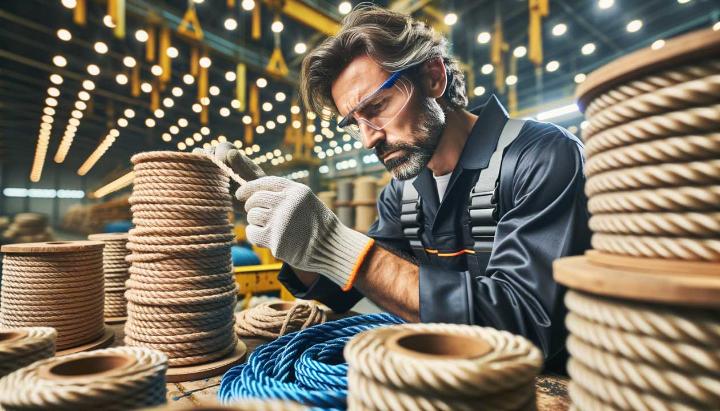Imagine dangling from a sheer cliff face, your life hanging by a mere thread – or rather, a slender rope meticulously engineered to withstand unimaginable forces. Picture a bustling construction site, where colossal machines are suspended mid-air by steel cables, defying gravity with their sheer strength. In these high-stakes scenarios, the integrity of a rope isn't just a matter of performance; it's a matter of life and death.
At iRopes, we understand the critical importance of rope strength, which is why we've devoted ourselves to the relentless pursuit of maximizing it. From the meticulous selection of raw materials to innovative manufacturing techniques, our unwavering commitment to quality control ensures that every fiber, every strand, and every cable we produce delivers unparalleled strength and resilience.
In this comprehensive guide, we'll dive deep into the world of nylon and wire ropes, uncovering the secrets to maximizing their strength and empowering you to tackle even the most demanding challenges with confidence. Whether you're scaling towering heights or lifting colossal loads, our insights will equip you with the knowledge to choose and maintain ropes that never compromise on safety or performance.
• iRopes’ coating cover on the whole rope,very good abrasion. Longer use life extra
with 100mm length black rubber cover until thread wrap part PU different color
Coating very good abrasion.avaliable in different eye colour .
MATERIAL: Nylon core Nylon cover
CONSTRUCT: double braided
ELONGATION: 30%
Understanding Rope Strength: Tensile Strength vs Working Load
Imagine you're scaling a towering cliff face, with nothing but a sturdy rope securing your ascent. Or picture hoisting heavy machinery at a construction site, relying on cables to lift tons of weight safely. In scenarios like these, rope strength isn't just a matter of convenience – it's a matter of life and death.
But how do we measure and understand this critical aspect of rope performance? Two key metrics come into play: tensile strength and working load limit.
Factors Affecting Rope Strength
- Rope material is the first factor that determines strength. From robust nylon and polyester to the featherweight yet incredibly strong HMPE (Dyneema) and LCP, different fibers offer varying levels of tensile power.
- Construction and diameter also play a role. Braided ropes often pack more strength than twisted ones, and thicker diameters can typically handle higher loads.
- Environmental conditions like abrasion, UV exposure, and chemicals can degrade rope fibers over time, weakening their overall strength.
- Handling and knotting can significantly impact a rope's load-bearing capacity. A carelessly tied knot, for instance, can reduce strength by up to 50%.

Understanding these factors is crucial for selecting the right rope and maximizing its potential strength.
Strongest Rope Materials and Their Characteristics
When it comes to sheer muscle power, certain rope materials stand out from the pack:
- Nylon is a versatile workhorse, offering excellent strength, abrasion resistance, and elasticity. It's a popular choice for everything from climbing ropes to industrial lifting slings.
- Polyester boasts impressive tensile strength and resistance to UV rays and chemicals, making it a go-to for outdoor applications like sailing and arborist ropes.
- HMPE and LCP are the true heavyweights, with incredible strength-to-weight ratios that make them ideal for lightweight yet ultra-strong cables used in industries like maritime, aerospace, and defense.
Choosing the right material is just the first step. The real strength lies in the meticulous manufacturing process, where quality control and precision techniques ensure every fiber reaches its full potential.
Maximizing Nylon Rope Strength
Have you ever marveled at the sheer power of a slender nylon rope, capable of suspending daring climbers hundreds of feet above the ground or hoisting massive loads at construction sites? The secret to this impressive strength lies in a meticulous manufacturing process, where every fiber is carefully optimized to reach its full potential.
Factors Affecting Nylon Rope Strength
- Rope diameter and thickness play a pivotal role in determining overall strength. Thicker ropes can withstand higher loads, making them ideal for heavy-duty applications.
- Material composition is equally crucial. High-quality nylon fibers, combined with robust cores and coatings, contribute significantly to the rope's tensile power.
- Weaving patterns also impact durability. Braided nylon ropes often outperform twisted ones, as the weave evenly distributes tension across multiple strands.
- Handling and usage can make or break a rope's lifespan. Proper care, avoiding knots that compromise strength, and protecting against environmental hazards like abrasion and UV exposure are essential.

Techniques for Increasing Nylon Rope Strength
At iRopes, we leave no stone unturned in our pursuit of unparalleled nylon rope strength. From meticulous material selection to advanced manufacturing techniques, every step is carefully engineered to maximize performance.
- High-strength nylon fibers form the backbone of our ropes, carefully sourced and tested to ensure optimal tensile properties.
- Fiber reinforcements like Kevlar can further enhance strength while maintaining flexibility and lightweight characteristics.
- Heat treatment processes improve molecular alignment and crystallinity, boosting the rope's overall resilience.
- Surface treatments and coatings protect against abrasion, UV radiation, and chemical exposure, extending the rope's lifespan.
- Precision braiding techniques evenly distribute tension across multiple strands, resulting in ropes that can withstand incredible loads without compromising flexibility.
But strength isn't the only advantage of nylon ropes – their incredible versatility makes them invaluable across a wide range of applications. From rock climbing and sailing to industrial lifting and arborist work, nylon ropes offer an unbeatable combination of strength, durability, and flexibility. For more on versatile nylon options, check out our guide on 2 and 1.5 Nylon Rope Solutions.
So, whether you're scaling towering cliffs or securing heavy machinery, trust in the power of meticulously engineered nylon ropes from iRopes. Our commitment to quality control and innovative manufacturing techniques ensures every fiber delivers unparalleled strength, empowering you to tackle even the most demanding challenges with confidence.
Enhancing Wire Rope Strength
In the world of heavy-duty industrial operations, wire ropes play a crucial role, shouldering immense loads and enduring grueling conditions. From towering cranes to deep-sea oil rigs, the strength of these steel cables is not just a matter of performance – it's a matter of safety. Imagine the catastrophic consequences of a cable failure during a critical lift or operation. That's why maximizing wire rope strength is an absolute necessity, and the pursuit of ever-stronger, more resilient cables is a never-ending quest for manufacturers and engineers alike.
But what exactly determines the strength of a wire rope? And how can we push the boundaries of current limitations to create cables that can withstand even greater forces? The answer lies in a combination of meticulous material selection, innovative construction techniques, and a deep understanding of the factors that contribute to overall rope strength.
Increasing Metallic Area and Fill Factor
One of the most effective ways to enhance wire rope strength is by maximizing its metallic area – the sum of the cross-sectional areas of all the individual wires within the rope. The higher the metallic area, the greater the rope's ability to withstand tensile forces. But how do manufacturers achieve this?
The solution often lies in increasing the fill factor, a measure of how tightly the wires are packed within the rope's strands. By using strands with higher fill factors or compacting the strands themselves, manufacturers can squeeze in more wires, boosting the overall metallic area and, consequently, the rope's breaking strength.

Another technique that can boost metallic area is rope swaging, where the rope is mechanically compacted to reduce the spaces between wires, resulting in a more densely packed and stronger cable.
Have you ever witnessed the sheer power of a massive crane lifting enormous loads with ease, all thanks to its wire rope rigging? That strength is often the result of these ingenious techniques, carefully engineered to maximize the rope's metallic area and fill factor.
Improving Tensile Strength of Wires
But increasing the metallic area is just one part of the equation. To truly unlock the full potential of wire rope strength, manufacturers must also focus on improving the tensile strength of the individual wires themselves.
The tensile strength of a wire is determined by factors such as its material composition, heat treatment processes, and cold-working techniques. By carefully selecting high-grade steel alloys and subjecting them to precise heat treatments, manufacturers can optimize the wire's molecular structure, enhancing its ability to withstand immense tensile forces without breaking. Take a closer look at how Dyneema is used in rigging, our go-to ultra-strong synthetic fiber solution.
Imagine the strength of a wire rope where each individual wire is a finely tuned, high-tensile powerhouse.
Furthermore, cold-working techniques like drawing or rolling can introduce beneficial residual stresses into the wire, further boosting its tensile strength and resistance to deformation.
By combining these advanced material engineering techniques with the maximization of metallic area, manufacturers can create wire ropes that truly push the boundaries of strength, enabling safer and more efficient operations in even the most demanding industrial environments.
Optimizing Spin Factor and Compaction
But the pursuit of wire rope strength doesn't stop there. Another critical factor that manufacturers must carefully consider is the spin factor, which refers to the amount of twist or spin imparted to the individual wires and strands during the rope's construction.
An optimized spin factor helps reduce stress concentrations and distribute loads more evenly across the rope's cross-section, ultimately enhancing its overall strength and stability. Manufacturers employ sophisticated preforming techniques to fine-tune the spin factor, ensuring that each wire and strand is properly bedded and aligned for maximum load-bearing capacity.
Complementing the spin factor optimization is the process of strand compaction, where the individual strands are tightly compacted to minimize internal movement and gaps. This not only improves the rope's overall metallic area but also contributes to its stability, reducing the risk of internal abrasion and premature wear. For more insights on how synthetic ropes like UHMWPE can offer strength and stability, explore UHMWPE Winch Ropes.
- Compaction
- Optimized spin factor
- Stability
By meticulously optimizing these factors, wire rope manufacturers can create cables that not only exhibit remarkable strength but also maintain their integrity and performance over extended periods of use, even in the harshest of environments.
Benefits of Wire Ropes in Heavy-Duty Applications
The relentless pursuit of wire rope strength is driven by the ever-increasing demands of heavy-duty industrial applications, where failure is simply not an option. From offshore oil platforms and mining operations to large-scale construction projects and shipbuilding, wire ropes are the unsung heroes that enable these critical endeavors.
- Unparalleled load-bearing capacity allows wire ropes to handle immense weights and forces, making them indispensable for lifting and hoisting operations.
- Exceptional durability and resilience ensure that wire ropes can withstand harsh environments, abrasion, and exposure to corrosive elements, minimizing downtime and maintenance requirements.
- Versatility and customization enable wire ropes to be tailored to specific application needs, whether it's resistance to extreme temperatures, flexibility for intricate rigging setups, or specialized coatings for added protection.
In these demanding industries, where safety and efficiency are paramount, the strength of wire ropes is not just a matter of performance – it's a matter of life and limb. That's why manufacturers like iRopes are constantly pushing the boundaries, leveraging cutting-edge materials and techniques to create wire ropes that can withstand the most extreme conditions and meet the ever-increasing demands of our modern world.
Get in Touch to Maximize Your Rope Strength
Understanding rope strength, particularly wire rope strength and nylon rope strength, is crucial across various applications, from climbing to industrial lifting. iRopes excels in ensuring maximum rope strength through meticulous quality control of raw materials, optimised fibre and wire strength, and precision manufacturing techniques. Our offerings in high-strength nylon and wire ropes cater to both durability and specific industry needs. Fill in the inquiry form above to learn more about our products and services tailored to enhance rope strength for your unique requirements.